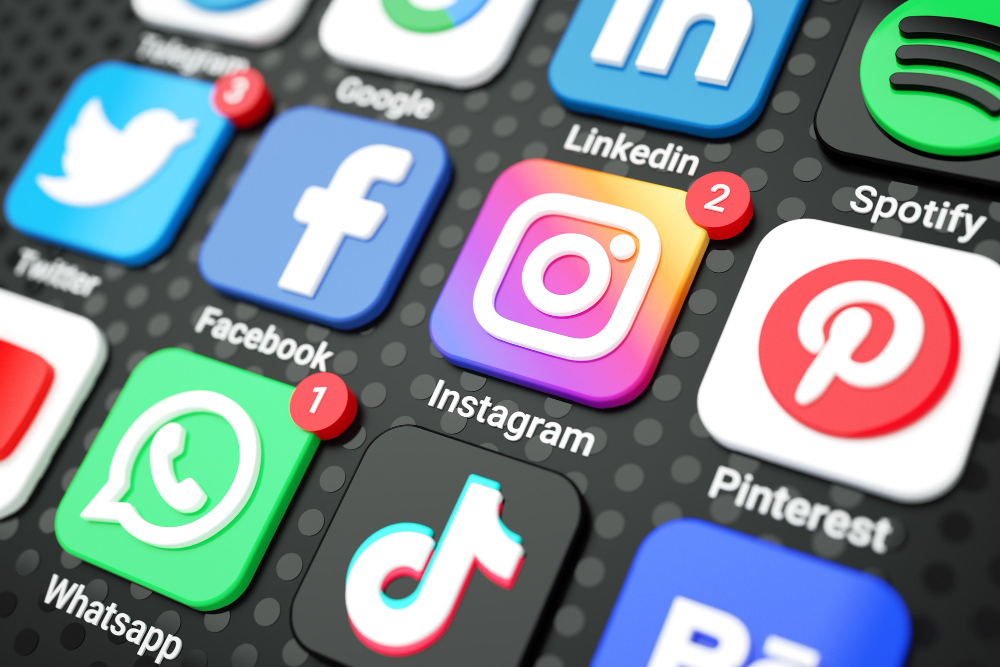Digital marketing encompasses a wide range of tactics and strategies that are designed to reach consumers where they spend most of their time: online. This includes using social media platforms, email marketing, search engine optimization, mobile apps, and other forms of digital media to promote products and services.

One of the key benefits of digital marketing is its ability to reach a large and targeted audience at a relatively low cost. It also allows for real-time tracking and analysis of the success of marketing campaigns, which enables marketers to make data-driven decisions and optimize their efforts.
Another advantage of digital marketing is its ability to facilitate two-way communication between brands and consumers. This enables companies to build relationships with their customers and gather valuable feedback that can inform future marketing efforts.
Overall, digital marketing has been a valuable tool for brands looking to connect with and engage their target audiences in the online space. Below, we will talk about the different marketing trends that surfaced in 2022 as well as the trends that will still make it to 2023.
Augmented Reality Digital Marketing
Augmented reality (AR) is a technology that allows marketers to overlay digital content onto the real world, creating an immersive and interactive experience for users. One way that AR can be used in digital marketing is through the use of AR filters on social media platforms like Instagram and Snapchat. These filters allow users to try on virtual makeup, hairstyles, or other products to see how they would look in real life. Brands can create their own AR filters and promote them on social media to encourage users to try them out and engage with their products.
In addition to AR filters, there are many other ways that AR can be used in digital marketing. For example, brands can create AR ads that appear in the camera view of a user’s smartphone, allowing them to interact with the ad in a more immersive way. AR can also be used in e-commerce to allow customers to virtually try on clothes or see how furniture would look in their home before making a purchase.
Overall, AR can be a powerful tool for digital marketing as it allows brands to create interactive and immersive experiences for their customers. By leveraging AR technology, brands can stand out in a crowded online marketplace and effectively promote their products and services.
NFT Marketing
Non-fungible tokens, or NFTs, are a type of digital asset that represents ownership of a unique item or piece of content. They are designed to be non-interchangeable and cannot be replaced by other assets. This makes them particularly useful for digital marketing, as they allow brands to sell unique, limited-edition products or experiences to customers.
For example, a brand could use NFTs to sell exclusive access to virtual events or experiences, such as concerts or meet-and-greets with celebrities. NFTs could also be used to sell limited-edition digital collectibles, such as virtual artwork or trading cards. In these cases, the NFT serves as a proof of ownership and authenticity for the unique item being sold.
In addition to selling unique products or experiences, NFTs can also be used as a way for brands to reward their customers or loyal followers. For example, a brand could offer NFTs as part of a loyalty program, where customers can earn tokens by making purchases or engaging with the brand’s content. These tokens could then be redeemed for exclusive experiences or products.
Overall, NFTs offer a new and innovative way for brands to engage with their customers and offer unique, one-of-a-kind experiences. They provide a new avenue for digital marketing and have the potential to change the way brands interact with their customers online.
Content Marketing

Content marketing is a digital marketing strategy that involves creating and distributing valuable, relevant, and consistent content to attract and retain a clearly defined audience. This content can take many forms, such as blog posts, social media posts, videos, podcasts, ebooks, and more. The goal of content marketing is to establish trust and credibility with customers, ultimately leading to profitable customer action.
Content marketing can be an effective way for brands to attract and engage their target audience by providing them with valuable information and resources. For example, a company that sells outdoor gear may create a blog that provides tips and advice for outdoor enthusiasts, or a beauty brand may create video tutorials on how to use their products. By providing valuable content to their audience, brands can establish themselves as thought leaders in their industry and build trust with their customers.
In addition to attracting and retaining customers, content marketing can also help improve search engine rankings and drive traffic to a company’s website. By creating high-quality, keyword-rich content, brands can improve their visibility on search engines and attract more organic traffic. Ultimately, a well-executed content marketing strategy can help drive profitable customer action and support a brand’s overall marketing efforts.
What Digital Marketing Practices to Avoid in 2023

There are several digital marketing practices that you should avoid in order to protect your brand’s reputation and maintain the trust of your customers. These practices include:
Spamming: Spamming is the practice of sending unsolicited or unwanted emails or messages to a large number of people. This can include emails with subject lines that are designed to grab the recipient’s attention, but the content of the email has nothing to do with the subject line. For example, an email with the subject line “You won the lottery!” but the content of the email is actually a sales pitch for a product. Spamming is a bad digital marketing practice because it can lead to a significant loss of customers and damage to your brand’s reputation.
Misleading advertising: Misleading advertising is a digital marketing practice that involves making false or exaggerated claims about your products or services. This can include making claims that are not supported by scientific evidence or making claims that are not true. For example, a company may claim that their weight loss supplement is guaranteed to help you lose weight, but there is no scientific evidence to support this claim. Misleading advertising is a bad digital marketing practice because it can lead to customer dissatisfaction and damage to your brand’s reputation.
Invasive tracking: Invasive tracking is the practice of tracking customers’ online behavior without their knowledge or consent. This can include using cookies to track their browsing history or using their personal information for targeted advertising. Invasive tracking is a bad digital marketing practice because it can be a violation of customers’ privacy and lead to a loss of trust in your brand.
Lack of security: Protecting customer data and ensuring the security of your website and online platforms is crucial in the digital marketing world. A lack of security can result in data breaches, which can compromise customer information and lead to a loss of trust in your brand. For example, if a customer’s credit card information is stolen due to a lack of security on your website, they may lose trust in your brand and be less likely to make future purchases.
By avoiding these bad digital marketing practices, you can protect your brand’s reputation and maintain the trust of your customers. It is important to be transparent, honest, and respectful of your customers’ privacy in your digital marketing efforts in order to build trust and establish a positive reputation.
Bad marketing practices can have dangerous effects on a brand or business. These practices can damage the reputation of the brand and lead to a loss of customers and revenue. Some of the dangerous effects of bad marketing include:
Loss of trust: When a brand engages in deceptive or dishonest marketing practices, it can lead to a loss of trust from customers. This can be particularly damaging for a business as trust is a crucial factor in customer loyalty and repeat business.
Negative brand image: Bad marketing practices can create a negative image of a brand in the minds of consumers. This can be difficult to change, even if the brand takes steps to improve its marketing efforts in the future.
Decreased sales: When a brand’s reputation is damaged due to bad marketing practices, it can lead to a decline in sales. Customers may be less likely to make purchases from a brand that they do not trust or have a negative image of.
Legal consequences: Some bad marketing practices, such as making false or misleading claims about products or services, can result in legal consequences. This can include fines and legal action, which can be costly and damaging to a brand’s reputation.
Overall, it is important for brands and businesses to avoid bad marketing practices in order to protect their reputation and maintain the trust of their customers. By engaging in honest and transparent marketing efforts, brands can build a positive reputation and increase their chances of success.
Digital Marketing Techniques for 2023
It is difficult to predict exactly which digital marketing techniques will still be relevant in the future, as the field is constantly evolving and new technologies and platforms emerge. However, there are certain digital marketing techniques that are likely to remain relevant due to their effectiveness and ability to adapt to new technologies. These techniques include:
Content marketing involves creating and distributing valuable, relevant, and consistent content to a target audience in order to establish trust and credibility. This can include blog posts, social media posts, videos, podcasts, and more. By providing valuable content to their audience, brands can establish themselves as thought leaders in their industry and build trust with their customers.
Search engine optimization (SEO) is a digital marketing technique that involves optimizing a website to rank higher in search engine results. This can be achieved through various tactics, such as using relevant keywords, creating high-quality content, and obtaining backlinks from other websites. SEO is likely to remain a relevant digital marketing technique as long as search engines exist, as it can help drive organic traffic to a website and improve its visibility in search results.
Email marketing involves sending targeted and personalized emails to a list of subscribers in order to promote a brand or product. This can be an effective way to reach a specific audience and drive conversions. Email marketing is likely to remain a relevant digital marketing technique in the future due to its ability to reach a targeted audience and track the success of campaigns.
Social media marketing involves using social media platforms to connect with an audience, build brand awareness, and drive traffic to a website. Social media platforms are likely to continue to be an important part of digital marketing in the future, as they provide brands with a way to connect with their audience and engage with them in real time.
Mobile marketing involves using mobile devices and platforms to reach a target audience. This can include creating mobile-friendly websites and apps, as well as using SMS and push notifications to reach customers. As more and more people use their smartphones for online activities, mobile marketing is likely to remain a relevant digital marketing technique in the future.
The Bottom Line
In 2023, it will be important for brands and businesses to practice good digital marketing techniques in order to effectively promote their products and services and build a positive reputation.
Good digital marketing techniques include creating and distributing valuable, relevant, and consistent content; optimizing a website for search engines; sending targeted and personalized emails to a list of subscribers; using social media platforms to connect with an audience; and utilizing mobile devices and platforms to reach a target audience.
By practicing these techniques and being transparent, honest, and respectful of their customer’s privacy, brands and businesses can build trust and establish a positive reputation in the digital world.






